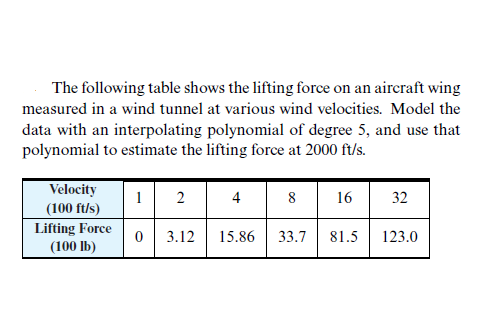The following table shows the lifting force on an aircraft wing measured in a wind tunnel at various wind velocities. Model the data with an interpolating polynomial of degree 5, and use that polynomial to estimate the lifting force at 2000 ft/s. Velocity 1 2 4 8 16 32 (100 ft/s) Lifting Force (100 lb) 0 3.12 15.86 33.7 81.5 123.0
The following table shows the lifting force on an aircraft wing measured in a wind tunnel at various wind velocities. Model the data with an interpolating polynomial of degree 5, and use that polynomial to estimate the lifting force at 2000 ft/s. Velocity 1 2 4 8 16 32 (100 ft/s) Lifting Force (100 lb) 0 3.12 15.86 33.7 81.5 123.0
Algebra & Trigonometry with Analytic Geometry
13th Edition
ISBN:9781133382119
Author:Swokowski
Publisher:Swokowski
Chapter4: Polynomial And Rational Functions
Section4.3: Zeros Of Polynomials
Problem 65E
Related questions
Question

Transcribed Image Text:The following table shows the lifting force on an aircraft wing
measured in a wind tunnel at various wind velocities. Model the
data with an interpolating polynomial of degree 5, and use that
polynomial to estimate the lifting force at 2000 ft/s.
Velocity
(100 ft/s)
1
4
8
16
32
Lifting Force
(100 lb)
3.12
15.86
33.7
81.5
123.0
Expert Solution
This question has been solved!
Explore an expertly crafted, step-by-step solution for a thorough understanding of key concepts.
This is a popular solution!
Trending now
This is a popular solution!
Step by step
Solved in 4 steps

Knowledge Booster
Learn more about
Need a deep-dive on the concept behind this application? Look no further. Learn more about this topic, advanced-math and related others by exploring similar questions and additional content below.Recommended textbooks for you

Algebra & Trigonometry with Analytic Geometry
Algebra
ISBN:
9781133382119
Author:
Swokowski
Publisher:
Cengage

Algebra & Trigonometry with Analytic Geometry
Algebra
ISBN:
9781133382119
Author:
Swokowski
Publisher:
Cengage